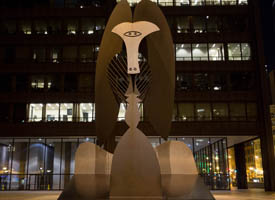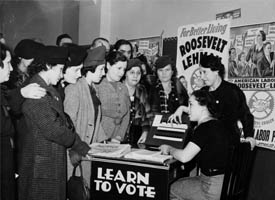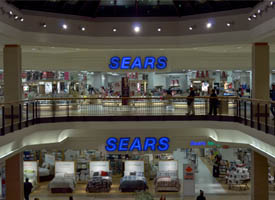- Details
 New Philadelphia, Illinois was located in western Illinois’ Pike County, not far from the Mississippi River and Missouri border. The town was founded by “Free” Frank McWorter, who moved to Illinois from Kentucky with his wife Lucy and their four children in 1830. McWorter founded the town of New Philadelphia in 1836 with a plan to make as much money as possible to buy his remaining family out of slavery and move them north to the new settlement.
New Philadelphia, Illinois was located in western Illinois’ Pike County, not far from the Mississippi River and Missouri border. The town was founded by “Free” Frank McWorter, who moved to Illinois from Kentucky with his wife Lucy and their four children in 1830. McWorter founded the town of New Philadelphia in 1836 with a plan to make as much money as possible to buy his remaining family out of slavery and move them north to the new settlement.
The town would suffer economically in the 1860s when a new railroad line bypassed the town, leading to a slow dispersal of residents from the area. By the 1880s, most residents had left the area in search of opportunity elsewhere.
Today, the area once incorporated as New Philadelphia is an open prairie field, with all remnants of the town underground. The significance of an integrated town existing before the Civil War, however, draws historians and others to the area.
In 2005, the town site was added to the U.S. National Register of Historic Places.
Learn more:
Read more about the history of New Philadelphia
- Details
 “The Picasso” sculpture, located in Daley Plaza in downtown Chicago, was unveiled 48 years ago this week. Designed by Pablo Picasso, the 50-foot steel structure was built when most public displays of art were monuments built in remembrance of historical figures or events. The sculpture is made of Cor-Ten steel which was assembled in nearby Gary, Indiana. The steel is the same composite used on the Daley Center skyscraper next door.
“The Picasso” sculpture, located in Daley Plaza in downtown Chicago, was unveiled 48 years ago this week. Designed by Pablo Picasso, the 50-foot steel structure was built when most public displays of art were monuments built in remembrance of historical figures or events. The sculpture is made of Cor-Ten steel which was assembled in nearby Gary, Indiana. The steel is the same composite used on the Daley Center skyscraper next door.
The new, modern look of Picasso’s sculpture was interpreted differently by many, with some saying it looked like a horse, bird or an abstract portrait of Picasso’s wife. Mayor Richard J. Daley was quoted saying it looked like the wings of Justice – fitting for the location next to a slew of courthouses and other legal offices.
Learn more:
Read more about the history of “The Picasso”
Learn more about the Richard J. Daley Center
- Details
 The 19th Amendment, which granted women the right to vote in all U.S. elections, passed Congress on June 4, 1919. At the time, more than 20 states denied women the right to vote, with another 12 allowing them to vote only in presidential elections.
The 19th Amendment, which granted women the right to vote in all U.S. elections, passed Congress on June 4, 1919. At the time, more than 20 states denied women the right to vote, with another 12 allowing them to vote only in presidential elections.
Once the amendment passed Congress, three-fourths of states needed to ratify it in order for it to become the law of the land. Illinois was one of the first states to ratify the amendment, along with neighboring Wisconsin and Michigan.
The amendment was officially ratified 95 years ago today when Tennessee narrowly passed the amendment, thus enshrining it to the Constitution.
Learn more:
Read more about the history of the 19th Amendment on History.com
- Details
 The Illinois State Fair was first held in 1853 in Springfield. At the time, state fairs were being held for the first time in many states as a way for farmers to learn about new technologies and practices they could take back to their fields.
The Illinois State Fair was first held in 1853 in Springfield. At the time, state fairs were being held for the first time in many states as a way for farmers to learn about new technologies and practices they could take back to their fields.
Today, the Illinois State Fair attracts nearly a million visitors during its 11-day run. While the fair still offers a host of agricultural-based shows and events, it also includes amusement rides, live concerts and an endless variety of food choices to ensure fun for the entire family.
Learn more:
Visiting the State Fair? Read more about concert line-ups, food offerings and events
- Details
 Julius Rosenwald was born on August 12, 1862. At the young age of 18, he was already involved in the fashion world. In 1895, Rosenwald became vice president and owner of one-third of Sears’ stock, then a mail-order-only business. Fourteen years later, Rosenwald would succeed Richard Warren Sears as president of the company.
Julius Rosenwald was born on August 12, 1862. At the young age of 18, he was already involved in the fashion world. In 1895, Rosenwald became vice president and owner of one-third of Sears’ stock, then a mail-order-only business. Fourteen years later, Rosenwald would succeed Richard Warren Sears as president of the company.
As president, Rosenwald stressed administration, system and order. Naturally, he also looked for any opportunities that could improve the business, such as looking for long-term merchandising deals with other companies. Rosenwald retained an astute business mind, which led the tycoon to have his store enter the retail store business.
Rosenwald was president of Sears until 1924, when he became chairman of the board of directors. He eventually stepped away from the Sears business to focus on social welfare philanthropy efforts.
Learn more:
Read more about Julius Rosenwald’s life and his generous philanthropy
Read more about the history of Sears
More Articles …
- Did You Know? The Web browser was invented in Illinois
- Did You Know? Illinois ranks high in Forbes’ business startup ranking
- Did You Know? Illinois hosts the oldest and largest black parade in the U.S.
- Did You Know? The cell phone was invented in Illinois
- Did You Know? MLB player Jim Thome is from Illinois





